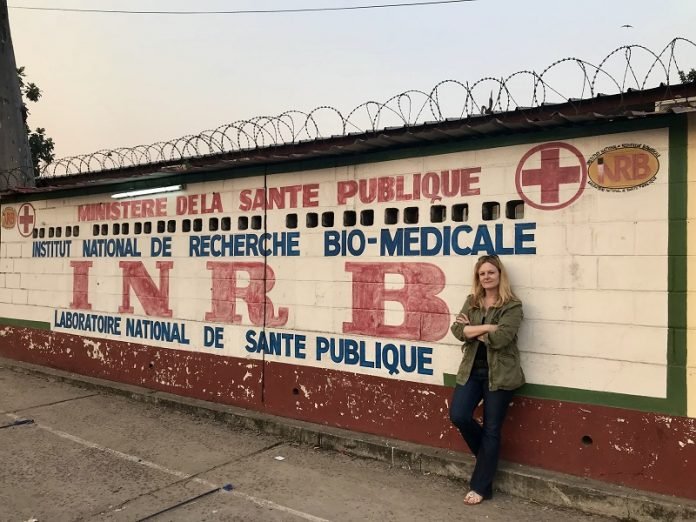
Monkeypox burst into the headlines this month after cases were diagnosed in Africa, Europe, North America and Australia.
In an interview, Anne Rimoin, the Gordon-Levin Professor of Infectious Diseases and Public Health at the UCLA Fielding School of Public Health, offered insights about the disease, which she has studied for two decades.
Rimoin has been director of the UCLA Center for Global and Immigrant Health and is the founder of the UCLA–DRC Health Research and Training Program in the Democratic Republic of the Congo.
In simplest terms, what is monkeypox?
Monkeypox is a viral zoonosis, a virus that is transmitted from animals to humans. It’s endemic in parts of Central and West Africa. Monkeypox is from the same family as smallpox but causes less severe disease.
It was discovered in the late 1940s, when outbreaks of a pox-like illness occurred in monkey colonies that were being used for research in Denmark — hence the name monkeypox. But the name is a misnomer. Monkeys can be infected by the virus, but it’s thought to be more commonly spread by small rodents and squirrels that are native to the forests of Africa.
There are two genetically distinct types, or clades, of the monkeypox virus. The Central African, or Congo Basin, clade and the West African clade. The Central African clade is thought to spread more easily and causes more severe disease.
How do people get monkeypox?
Transmission can occur when a person comes into contact with the virus from an animal, human or materials that are contaminated with the virus, known as fomites.
The virus enters the body through broken skin, the respiratory tract or mucous membranes — meaning the eyes, nose or mouth.
Animal-to-human transmission generally occurs from a bite or a scratch, preparing or eating wildlife, direct contact with body fluids or lesion material, or indirect contact through contaminated materials like bedding.
What are the symptoms?
The initial symptoms of monkeypox are typically flu-like. The first few days of symptoms include fever, headache, aches and pains, fatigue and swollen lymph nodes. Within a few days, a distinctive rash develops; the illness is usually self-limiting and lasts two to four weeks.
Monkeypox is a serious infection and can be fatal; mortality estimates range from 1% to 3.5% for the West African clade, and up to 10% for the Central African clade. But it’s important to note that these figures are from lower-resource African settings with more limited access to health care.
Of the cases that have been reported in high-resource settings — including the 2003 outbreak in the U.S. Midwest and importations to Europe, Israel, Singapore, the U.K. and U.S. — there have been no fatalities. This suggests that supportive care and treatment can be very effective.
Are there vaccines or therapeutics that can prevent or treat monkeypox?
Because monkeypox virus is closely related to smallpox virus, the smallpox vaccine can protect people from getting monkeypox. Past data from Africa suggests that smallpox vaccine is at least 85% effective in preventing monkeypox. Smallpox and monkeypox vaccines are effective at protecting people against monkeypox, when given before exposure to monkeypox.
And experts believe that vaccination after a monkeypox exposure may help prevent the disease or make it less severe.
Vaccination after exposure to monkeypox virus is still possible. However, the sooner an exposed person gets the vaccine, the better.
The U.S. Centers for Disease Control and Prevention recommends the vaccine be given within four days from the date of exposure in order to prevent onset of the disease. If given between four and 14 days after exposure, vaccination may reduce the symptoms of disease, but it may not prevent the disease.
In addition, there are treatments licensed for smallpox that can be used to treat cases of monkeypox including cidofovir, ST-246, and vaccinia immune globulin.
How concerned should people be?
The risk of monkeypox to the general public is very low. Monkeypox is still a very rare infection and only a few cases have been identified so far in the U.S.
That said, whenever we see a virus behaving differently or spreading in a new population, it’s concerning. We are seeing the virus move through populations in ways we haven’t seen before, so it is a situation that requires rapid attention, and a lot of study and action.
The bottom line is, monkeypox is a rare disease. It’s unlikely that most people in the U.S. will ever come in contact with it. While it’s a substantial illness, it hasn’t caused any fatalities in high-income settings. There are vaccines and treatments. And the world is more aware of what it takes to contain outbreaks.
If you care about monkeypox, please read studies about whether monkeypox is the next COVID-19 and the secret behind a monkey’s poker face.
Written by Brad Smith.



